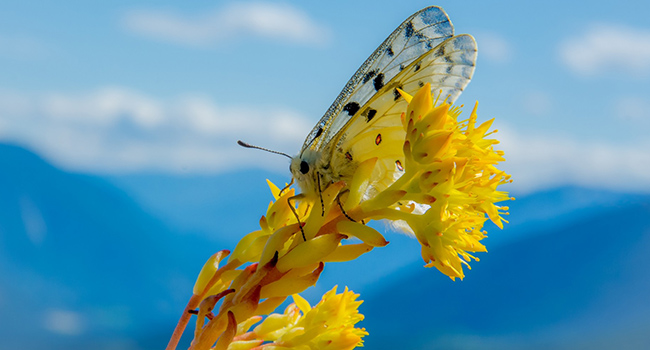In an essay written for the third annual State of the Mountains report by the Alpine Club of Canada, University of Alberta Department of Renewable Resources PhD student Zac MacDonald, along with U of A Biological Sciences professor Felix Sperling and registered professional forester William Sperling, outlined the need for more research into the adaptability and life cycle of these alpine creatures that have adapted to endure in particularly harsh environmental conditions.
The reason alpine butterflies are so interesting to climate change experts is that they have relatively rapid life cycles, most often completing one every year so their populations respond to changes quite rapidly.
For example, female Rocky Mountain apollo butterflies will lay eggs singly on the undersides of rocks or vegetation near the plant the caterpillar will feed on in the springtime. The overwintering eggs depend on a deep snowpack to insulate them from the cold alpine temperatures in the winter.
“I think the alpine is becoming much more variable and a lot more green, so it’s difficult to predict when these butterflies are going to emerge, or even if they have a climate window to complete a life cycle,” said MacDonald.
The trio explained human influences in combination with global climate change and fire suppression has resulted in visible encroachment of trees into alpine meadows across Alberta and British Columbia. Rising treelines don’t just mean less habitat; they also diminish the number of butterflies flying between mountains.
Such dispersal events are needed to inject genetic diversity into dwindling populations that see generations live solely in a single meadow already slowed by impenetrable mountain ranges.
“Alpine butterflies are the ultimate sentinel because they’re easy to find, the populations respond quickly to change and they can proxy environmental change at a very fine scale,” said MacDonald.
“However, there’s a lot of evidence and reasoning to suggest that they’re going to be in big trouble because mountain ecosystems are predicted to change a lot more drastically than other ecosystems with climate change.”
Unfortunately, save for a few studies – including one by U of A biological sciences professor emeritus Jens Roland that provides a long-term look at butterflies in a meadow network at Jumping Pound Ridge – there aren’t a lot of alpine butterfly monitoring programs in place.
“We wrote the article to encourage more monitoring,” said MacDonald. “Because these ecosystems are so inaccessible, we’re trying to get alpine enthusiasts and the outdoor community motivated to start submitting their sightings so we know what’s going on.”
Heading up the State of the Mountains report for the third straight year are U of A mountain historian Zac Robinson in the Faculty of Kinesiology, Sport, and Recreation; former U of A ecologist David Hik, who is now with Simon Fraser University; and Lael Parrott, professor of sustainability at the University of British Columbia, Okanagan.
Robinson said while the pandemic pushed back the release of the report from May until now, it also provided a theme for the report.
“The tumultuous 2020 has been a reminder to all of us just how fortunate we are to have these wilderness places to recreate and to explore,” said Robinson. “As we were staying closer to home trying to seek activities that are safe to do in a pandemic, I think more and more people, in a twist of fate, rediscovered our parks and our trails and our mountain spaces.”
People didn’t necessarily need to venture outdoors to enjoy the mountains, either. The report mentions that the U of A’s massive open online course Mountains 101 saw a surge in registrations in April the likes of which administrators hadn’t seen since the first month of its launch back in 2017.
Other U of A contributions include an essay by U of A alumnus Scott Williamson, now a post-doctoral at the University of Northern British Columbia, about how rates of warming at the highest points in Canada’s tallest mountains are almost five to six times faster than in other jurisdictions.
As well, Stephen Johnston, a researcher in the Department of Earth and Atmospheric Sciences, wrote about how the formation of the North American Cordillera – the great range of mountains that string along the western edge of the continent – defies the rules that govern mountain building in other places in the world.
“The State of the Mountains report is a great opportunity to talk about some of the scientific issues and questions that we deal with,” said Johnston.
“I think the more you understand something, the more you appreciate it. The more people understand about the mountains, the more they want to go see them, play in them and look after them.”
| By Michael Brown
This article was submitted by the University of Alberta’s online publication Folio, a Troy Media content provider partner.
The views, opinions and positions expressed by columnists and contributors are the author’s alone. They do not inherently or expressly reflect the views, opinions and/or positions of our publication.




